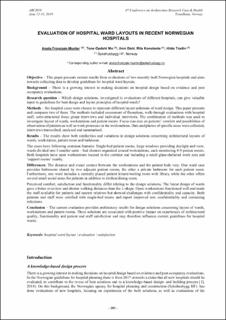| dc.description.abstract | Objective – This paper presents current results from evaluations of two recently built Norwegian hospitals and aims towards collecting data to develop guidelines for hospital ward layouts.
Background – There is a growing interest in making decisions on hospital design based on evidence and post occupancy evaluations.
Research question – Which design solutions, investigated in evaluations of different hospitals, can give valuable input to guidelines for best design and layout principles of hospital wards?
Methods – Six hospital cases were chosen to represent different layout solutions of ward design. This paper presents and compares two of them. The methods included assessment of floorplans, walk-through evaluations with hospital staff, semi-structured focus group interviews and individual interviews. The combination of methods was used to investigate layout of wards, workstations and patient rooms. Focus was also on patients’ comfort and possibilities of observation of patients as well as work processes in the workstations. Data and photos of specific areas were collected, interviews transcribed, analysed and summarised.
Results – The results show both similarities and variations in design solutions concerning architectural layouts of wards, workstation, patient room and bathroom. The cases have following common features: Single-bed patient rooms, large windows providing daylight and view, wards divided into 3 smaller units – bed clusters organized around workstations, each monitoring 8-9 patient rooms. Both hospitals have open workstations located in the corridor and including a small glass-sheltered work area and ‘support rooms’ nearby.
Differences: The distance and visual contact between the workstations and the patient beds vary. One ward case provides bathrooms shared by two adjacent patient rooms, the other a private bathroom for each patient room. Furthermore, one ward includes a centrally placed patient leisure/waiting room with library while the other offers several small social areas for patients in addition to kitchen/dining room. Perceived comfort, satisfaction and functionality differ relating to the design solutions. The linear design of wards gave a better overview and shorter walking distances than the L-shape. Open workstations functioned well and made the staff available for patients and nearest relatives but showed challenges with confidentiality and capacity. Both patients and staff were satisfied with single-bed rooms and report improved rest, confidentiality and containing infections.
Conclusion – The current evaluation provides preliminary results for design solutions concerning layout of wards, workstations and patient rooms. These solutions are associated with positive impact on experiences of architectural quality, functionality and patient and staff satisfaction and may therefore influence current guidelines for hospital wards. | |

